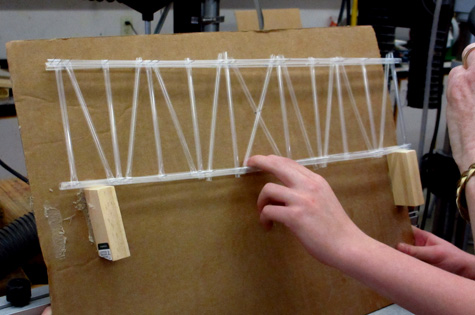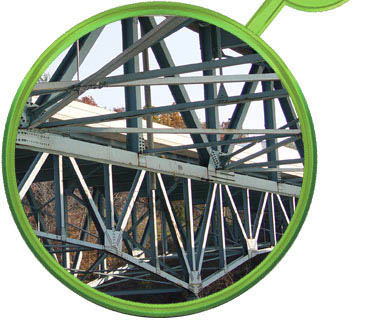Weston Middle School
Technology/Engineering Course Materials
Introductory Video: Pushing to Failure
- Working in partners, We will be building prototype beam bridges using straws and pins, and measuring their efficiency
- Efficiency= Live Load(Capacity)/Dead Load
- Bridges will be 20” long, 4” wide
- Top surface should be long beams
- Label Foam Boards- will be used as jigs


For a given number of lengthwise beams, why does the height of the beam (web) matter?

Demo hinged I-beam model

Do diagonal struts within the plane of the deck affect the vertical stiffness?
Demo measuring efficiency
- Do not become too committed to bridge design- it will be changed at least 3 times!
- What matters is that you are trying different designs, and analyzing how they fail
- The design cycle- pick a solution- build-test-redesign
- Measure Efficiency of Beam Bridge using water bottles as weights( 1 8 oz bottle = 280 gm)- see testing form
- How is it failing? How Can it be strengthened?
- # of beams; height of beams
- Review failures- should fail in bending, not in connections
- Keeping straws in one plane important
- Complete testing sheet
Mass Production of Beam Bridges

Highway Beam Bridge
( MassPike)- Weston
Practice building a truss using straws-
Building Procedure:
- Pin Pairs of long beams to plans
- Insert vertical members, pin in place
- Insert diagonal members, pin in place
- Trim extra straws
- Carefully remove truss from board, bend over pins with pliers
- Repeat Procedure for 2nd truss
-
Lesson 2:
- Introduce Truss styles- see Truss Diagrams
- Trusses are beams made of triangles, such that all elements are always in compression or tension ( not bending or shear)
- The greatest bending moment( load x distance from support) is in the middle
- Types
of Trusses :
-
- King Post/Queen Post
- Warren Truss:


- Pratt Truss/Howe Truss:

- Bowstring Bridge:

- Lenticular Truss:

- Trusses will pin on to sides of deck

Sketch 3 possible designs- choose 1 to build
- Design Trusses on graph paper- make two copies
- Make using foam board jig- try different designs- show on board

-
-
-
-
-
Truss showing gussets
-
Building Procedure:
- Pin Pairs of long beams to plans
- Insert vertical members, pin in place
- Insert diagonal members, pin in place
- Trim extra straws
- Carefully remove truss from board, bend over pins with pliers
- Repeat Procedure for 2nd truss
-
Test Trusses- Where does it bend?

- top bracing
- bottom bracing
- portal bracing- (there are three dimensional planes).
- Why is a truss efficient?
- Test for efficiency= Live Load( capacity)/ Dead Load( weight of bridge)
- Weigh bridge to determine dead load.
- Test strength using water bottles(280 gm) , calculate efficiency.
- HOW DOES IT SPECIFICALLY FAIL?
Lesson 3: Connect trusses with cross pieces. Add
Lesson 3-4: Load Test to close to failure- analyze weak points- reinforce where failing
Point loads will be applied close to center, so that the moment (=force x length ) varies directly with the load.
Why do bridges have trusses in 3 different planes?
Complete Truss
Bridge Analysis Worksheet
If done- improve bridge; tape joints, assist other students; make small arch bridge or suspension bridge
Alternative: Suspension Bridge- Man Who Would be King
Truss Bridge Analysis Worksheet






